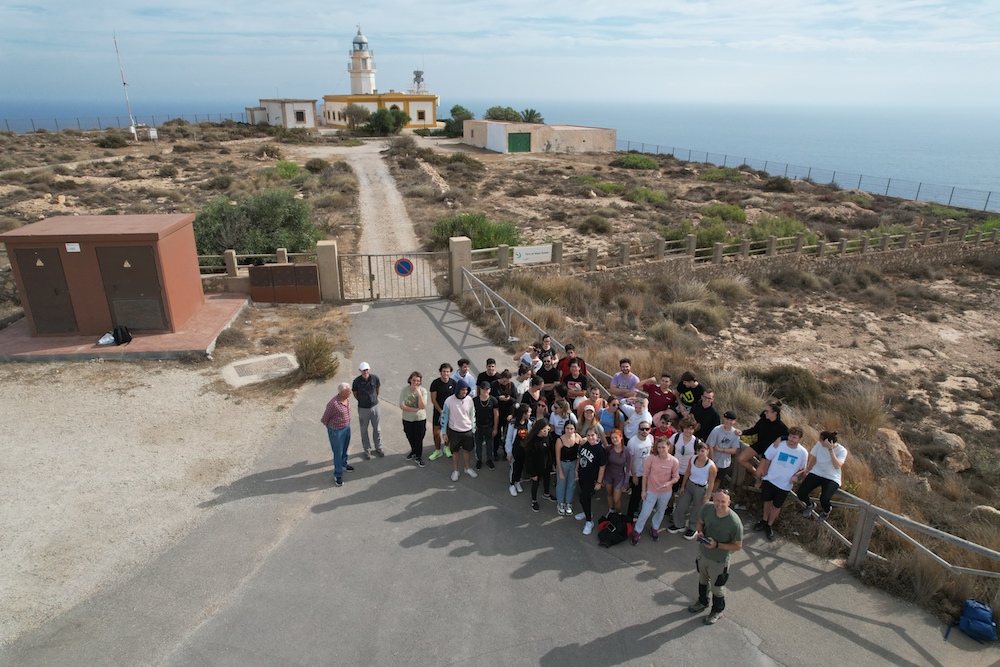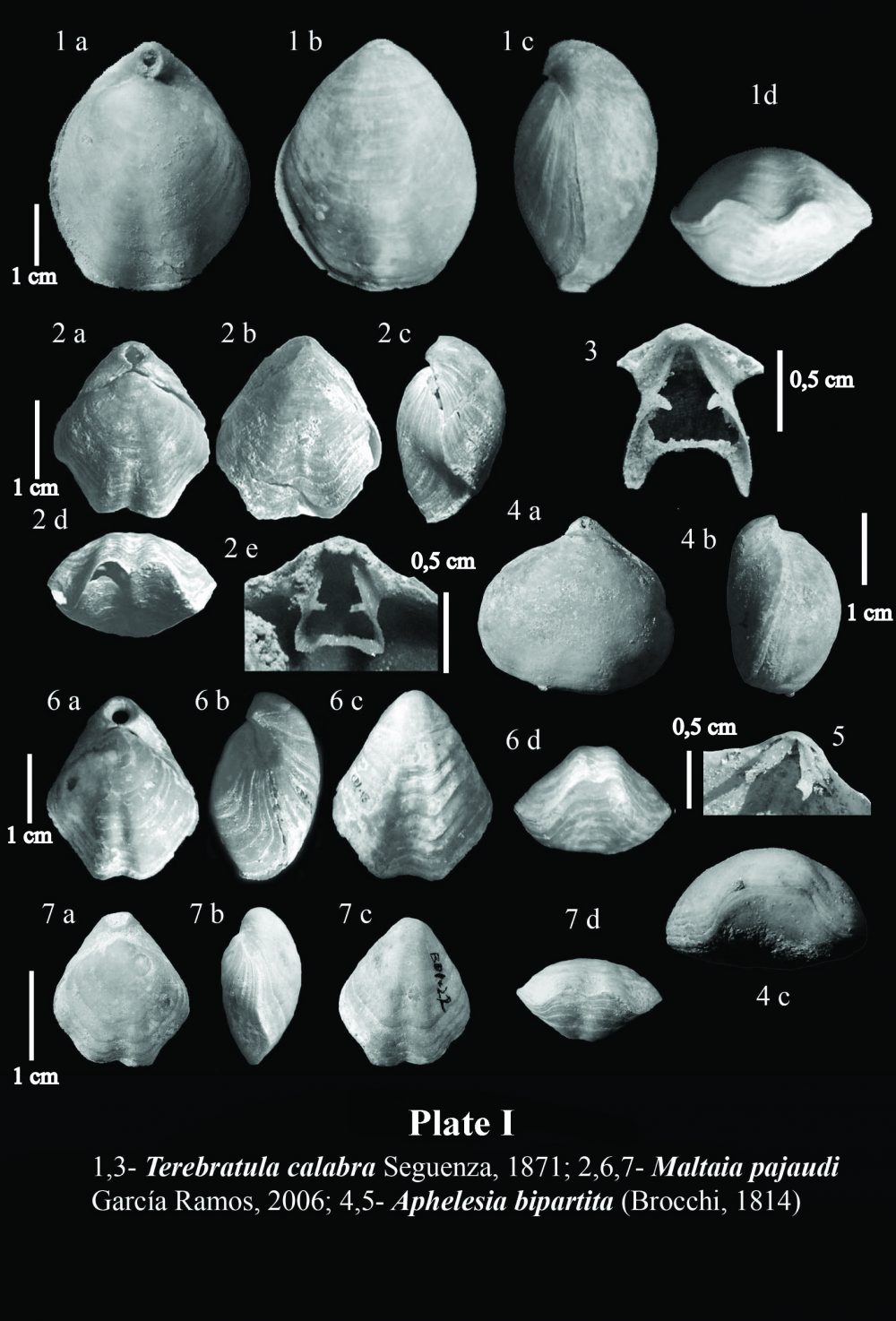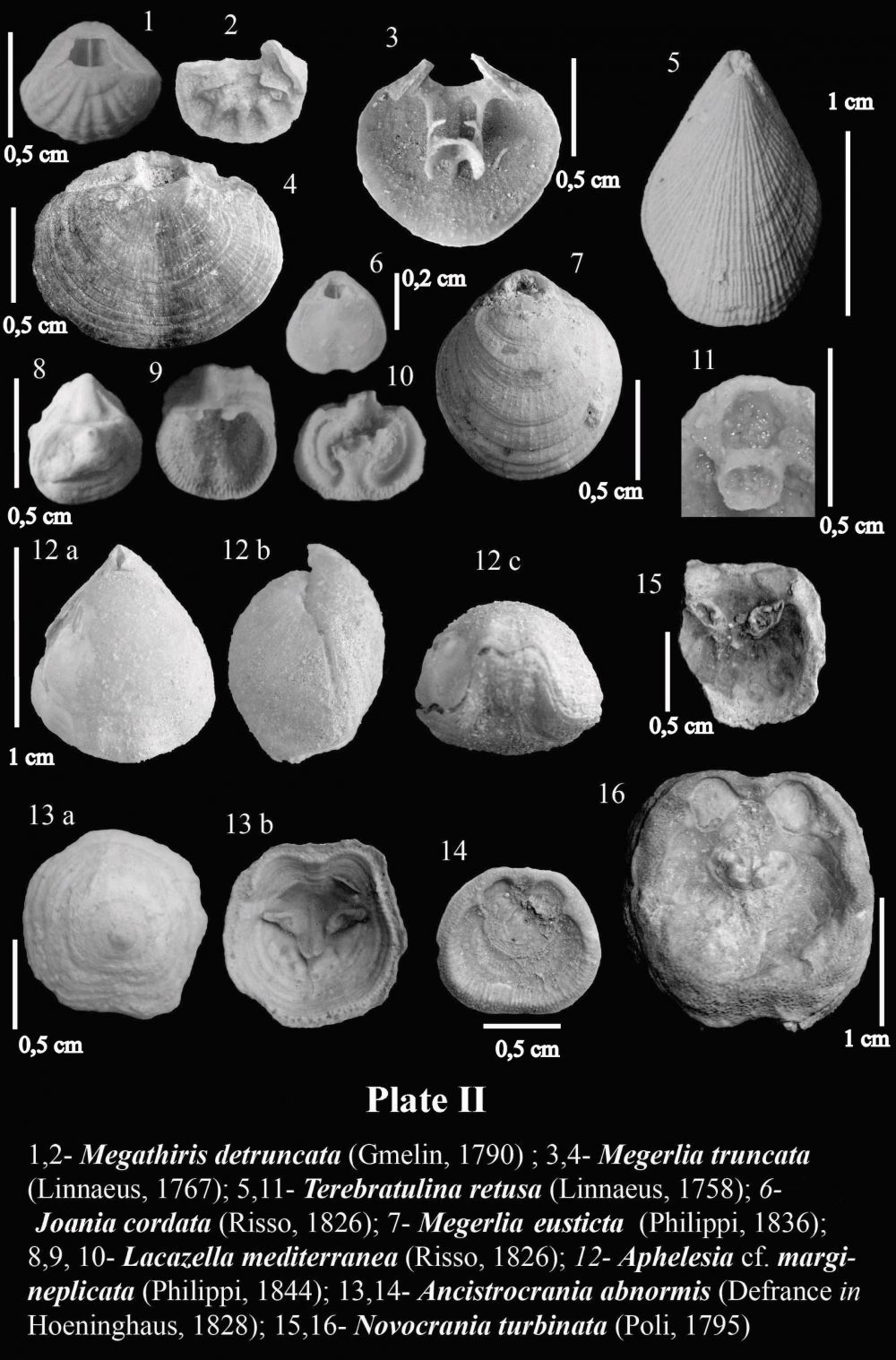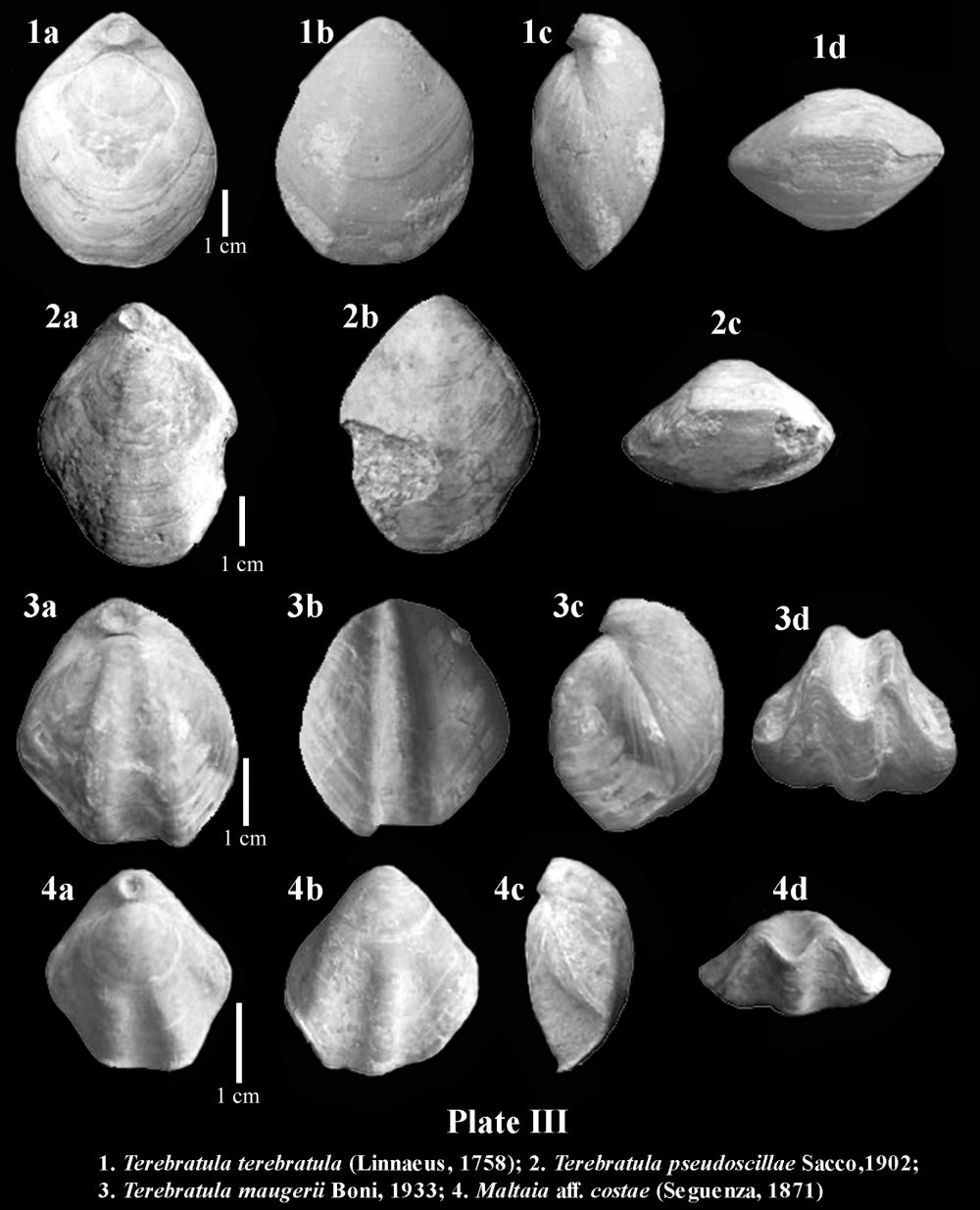Home » Posts tagged 'Betic cordillera'
Tag Archives: Betic cordillera
Field trip to Faro de Rondan (Almería)
This year the students of the third course of Marine sciences of the Alicante University visit the Sorbas basin, Cabo de Gata, and Mesa de Roldán on November 3th and 4th of 2022.

The picture show the student visiting the Faro de la Mesa de Roldan (the lighthouse).
The professors of the subject were Antonio Estévez, Manuel Martín-Martín and José Enrique Tent-Manclús.
Neogene Brachiopods and Betic Corridors
Diego García-Ramos
University of Vienna, Institut for Paläontologie
1.Introduction
Brachiopods, a name that derives from Ancient Greek words βραχίων (“arm”) and πούς (“foot”), make up a phylum of tripoblastic, coelomate, marine invertebrates that belong, along with bryozoans and phoronideans, to the superphylum of the so-called lophophorates. Their body plan consists of two valves displaying bilateral symmetry, and are generally inequivalve. Most brachiopods are sessile, stenohaline suspension feeders, and their fossil record spans from Lower Cambrian times to Recent. Today’s brachiopod diversity shows that they constitute a relic group of animals when compared with their paleobiodiversity during past geological time, especially in the Paleozoic, throughout which brachiopods were extremely diverse and abundant. Nowadays there are some 391 extant species of which around 5 % may be synonyms (Emig et al., 2013). Extant brachiopods are distributed from the intertidal zone to abyssal depths, but they occur more frequently in the inner and outer shelf, and the epibathyal zone.
- Brachiopods as paleocological and paleobiogeographical proxies
Since brachiopods are overall facies dependent organisms (Ager, 1965), together with the fact that many of their species display a long-ranging vertical distribution, their use as guide-fossils is limited in comparison with other groups like ammonoids and calcareous micro- and nannoplankton, despite the fact that many Paleozoic brachiopods are important biostratigraphical markers. In any case, the precise feature that they are facies-linked animals make brachiopods considerably suitable for paleoecological and paleogeographical studies. In particular, Ager (1967) outlined a number of reasons why fossil brachiopods may be of great use in paleoecological studies: 1) their great abundance throughout the Phanerozoic; 2) their occurrence in diverse sedimentary facies; 3) their susceptibility to environmental differences and perturbation; 4) the fact that their skeletal traits record physiological differences which are related to their life habit; and 5) the survival, with a relatively adequate diversity, of modern representatives which may aid in actuopaleontological analyses.
As for their use in paleobiogeography, Smirnova (2012) stressed the fact that brachiopods, most of which were/are fundamentally shelf dwellers, are good proxies to estimate the proximity of the coastline, and enable to contour marine basins accurately. Other than that, she also pointed out that brachiopods are sensitive to climatic factors, and the taxonomic composition of brachiopods has been proven to be a good tool in differentiating paleobiogeographical realms.
- Overview of Tertiary brachiopods from the Betic Cordillera
Brachiopods in the Tertiary record of the Betic Cordillera are relatively poorly known. There are sparse citations in old publications such as that of Davidson (1864), who mentioned the occurrence of Megerlia truncata(Linnaeus, 1767) in the Miocene of Gibraltar, or Terebratula sinuosa (Brocchi, 1814) in Miocene rocks from Córdoba (Davidson, 1870) (later known to be Terebratula maugerii Boni, 1933). Kilian in Fouqué (1884) cited a number of species of Terebratula, besides the rhynchonellid and thecideid brachiopods Aphelesia bipartita(Brocchi, 1814) and Lacazella mediterranea (Risso, 1826), from the Neogene record of the Granada Basin.
A general glance at Cainozoic (but mainly Neogene) brachiopod paleobiodiversity in the Betic Cordillera shows that the genus Terebratula Müller, 1776 prevails by far, making up more than 80% of the record of brachiopods during this era (Toscano et al., 2010). In rocks of Eocene age, terebratulids attributable to Carneithyris hilarionis (Davidson, 1870) are known to occur rarely in the province of Alicante (Sulser et al., 2010), and there is unpublished record of Upper Oligocene to Lower Miocene small gryphine brachiopods, along with Terebratulina gr. tenuistriata (Leymerie, 1846), in the province of Murcia.
Two main types of brachiopod assemblages may be recognized in Neogene deposits of the eastern Betic Cordillera: a relatively shallow water Terebratula–Aphelesia assemblage associated to fine-grained bottoms, forming Terebratulapavements or clumps, with sparse, solitary occurrence of Aphelesia, and a bathyal assemblage where small gryphine-like terebratulids and Ceramisia meneghiniana (Seguenza, 1865) are distinctive components, found in deep-sea hard-substrates and associated to bamboo-coral bioherms (see Barrier et al., 1991). Other taxa such as Megerlia truncata, Terebratulina retusa (Linnaeus, 1758) and Lacazella mediterranea display an euribathic distribution and may occur in both assemblages as long as there is suitable substrate. The micromorphic brachiopod Megathiris detruncata (Gmelin, 1790) and the inarticulate Ancistrocrania abnormis(Defrance in Hoeninghaus, 1828) have been found in infralittoral to circalittoral hard-substrates consisting either of shelly-grounds or rocky-grounds. Joania cordata (Risso, 1826) and Novocrania turbinata (Poli, 1795) have exclusively been found in hard-substrates corresponding to a circalittoral volcanic swell.

In sediments of Late Neogene age deposited the intramountaneous basins of the Betic Cordillera, the recurrent assemblage of species of the genera Terebratula -or its close relative Maltaia Cooper, 1983-and Aphelesia Cooper, 1959, has been already pointed out elsewhere by, for instance, Pedley (1976) and Gaetani (1986). During the Tortonian, the species Aphelesia margineplicata(Philippi, 1844) commonly co-occurred in silty to fine-grained sandy lithofacies in association with Terebratula maugeriior Terebratula pseudoscillae Sacco, 1902 (see also Calzada, 1978). In addition, it has also been found in the same outcrops together with Miocene representatives of Terebratula calabra Seguenza, 1871, or Maltaia aff. costae (Seguenza, 1871), in Late Tortonian to Early Messinian aged deposits, mainly interpretable as of infralittoral to circalittoral paleoenvironments.

The onset of the Messinian Salinity Crisis exerted a profound impact on practically the whole marine paleobiota of the Mediterranean at the end of Messinian times, and brachiopods were not an exception, but they were among the victims of this vast extinction. The restoration of normal marine conditions that followed the opening of the Strait of Gibraltar, leading to the Early Pliocene re-flooding, implied a re-colonization by brachiopods, ever since Terebratula and Aphelesia had survived in Atlantic waters (see, for example, Dollfus & Cotter, 1909 and Toscano et al., 2010). The taxonomic composition of Pliocene Terebratula–Aphelesiaassemblages of the Betic Cordillera marked a faunal turnover when compared to those prevailing during the Miocene. The species Aphelesia bipartita replaced A. margineplicata –which presence became marginal- as the dominating partner of Terebratula (e.g. Pajaud, 1976). Likewise, T.pseudoscillae and the once abundant Terebratula maugerii= T. sinuosadied out. Their niche was taken over by Terebratula terebratula (Linnaeus, 1758), by Pliocene morphotypes of Terebratula calabra, and by Maltaia pajaudi García-Ramos, 2006.

4.Brachiopods and Betic Corridors
Reolid et al. (2012) have shown that the genus Terebratula might have likely thriven in the shelf margins of Atlantic-Mediterranean corridors by benefitting from warmer and more saline water currents flowing from the Mediterranean to the Atlantic. The occurrence of Terebratula in Betic intramountane basins that might perform as Atlantic-Mediterranean seaways can be traced as far back as to Early Miocene times (e.g. García-Ramos, 2006). Llarena (1934) mentioned the presence of Terebratula sp. and Terebratula grandis (probably T. pseudoscillae) in basins located within the Prebetic realm of the province of Albacete, and Darder Pericás (1945) likewise described outcrops yielding numerous specimens of Terebratula in Neogene basins of the Prebetic in the southern sector of the province of Valencia. All of these basins might be part of an interconnected web of Atlantic-Mediterranean seaways. Further studies are needed to solve the puzzle as to how the Atlantic-Mediterranean connections evolved in the Betic Cordillera as the Alborán Block was undergoing indentation against the Iberian paleomargin. The study of marine epibenthic macroinvertebrates, including brachiopods, may play a role in enhancing our knowledge of how all of this happened.
References:
Ager, D.V., 1965, The adaptation of brachiopods to different environments: Palaeogeography, Palaeoclimatology, Palaeoecology, 1, p. 143-172.
Ager, D.V., 1967, Brachiopod palaeoecology: Earth-Science Review, 2, p. 157-159.
Barrier, P., Zibrowius, H., Lozouet, P., Montenat, C., Ott d’Estevou, P., Serrano, F., Soudet, H. J., 1991, Une faune de fond dur du bathyal superieur dans le Miocene terminal des Cordilleres Betiques (Carboneras, SE Espagne): Mesogee (Bulletin du Museum d’Histoire Naturelle de Marseille), 51, p. 3-13.
Bertrand, M., Kilian, W., 1884, Études sur les terrains secondaires et tertiaires dans les provinces de Grenade et de Malaga, in : «Mission d’Andalousie » : études relatives au tremblement de terre du 25 décembre 1884 et à la constitution géologique du sol ébranlé par les secousses: Mém. Acad. Sci. Paris, 30 (2), p. 377–579.
Calzada B. S., 1978, Braquiópodos tortonienses de Murcia: Estudios geológicos, 34, p.351-358.
Davidson, T., 1864, Description of the Brachiopoda: in Adams S L. (ed.), Outline of the geology of the Maltese Islands. The Annals and Magazine of Natural History, Series 3, 14, p. 5-11.
Davidson, T., 1870, On Italian Tertiary Brachiopoda: Geological Magazine, London, 7 (8), p. 359-370, p. 399-408, p. 460-466.
Darder Pericás, B., 1945, Estudio geológico del sur de la Provincia de Valencia y norte de la de Alicante. Boletín Geológico y Minero de España, 57: p. 59-837.
Dollfus, G.F. & Cotter, J.C.B, 1909, Le Pliocène au Nord du Tage (Plaisancien).Brachiopoda. Commission du service géologique du Portugal, p. 87-90.
Emig, C. C., Bitner, M.A., Álvarez, F., 2013, Phylum Brachiopoda. In: Zhang, Z.-Q. (Ed.) Animal Biodiversity: An Outline of Higher-level Classification and Survey of Taxonomic Richness (Addenda 2013). Zootaxa, 3703, 1–82.
Gaetani, M., 1986, Brachiopod paleocommunities from the Plio-Pleistocene of Calabria and Sicilia (Italy). In: Biostratigraphie du Paléozoïque 4. Les brachiopodes fossils et actueles. P.R. Racheboeuf & Emig, C.C. (Ed.). p. 281-288.
García Ramos, D.A. 2006. Nota sobre Terebratulinae del Terciario de Europa y su relación con los representantes neógenos del sureste español. Boletín de la Asociación Cultural Paleontológica Murciana 5: 23-83.
Llarena, J.G. de, 1934, Observaciones sobre la geología y fisiografía de los alrededores de Hellín. Boletín de la Real Sociedad Española de Historia Natural, p.213-231.
Pajaud, D., 1976, Les Brachiopodes du Pliocène I de la Sierra de Santa Pola (sud d’Alicante, Espagne): Terebratula terebratula (Linné, 1758) et Phapsirhynchia sanctapaulensis nov. gen., nov. sp.: Annales de la Société géologique du Nord, 96, p. 99-106.
Pedley H. M., 1976, A palaeoecological study of the Upper Coralline Limestone, Terebratula-Aphelesia Bed (Miocene, Malta) based on bryozoan growth-form studies and brachiopod distributions: Palaeogeography Palaeoclimatology Palaeoecology, 20, p. 209-234.
Smirnova, T.N., 2012, Early Cretaceous Rhynchonellids of Dagestan: System, Morphology, Stratigraphic and Paleobiogeographic Significance. Paleontological Journal, v.46, nº 11, p. 1197-1296.
Reolid, M., García-García, F., Tomasovych, A. and Soria, J.M., 2012, Thick brachiopod shell concentrations from prodelta and siliciclastic ramp in a Tortonian Atlantic–Mediterranean strait (Miocene, Guadix Basin, southern Spain). Facies 58: 549-571.
Sulser, H., García-Ramos, D., Küsteiner, P., Menkveld-Feller, U., 2010, Taxonomy and palaeoecology of brachiopods from the South-Helvetic zone of the Fäneren region (Lutetian, Eocene, NE Switzerland). Swiss Journal of Geosciences, 103: p. 257–272.
Toscano-Grande, A., García-Ramos, D., Ruiz-Muñoz, F., González-Regalado, M.L., Abad, M., Civis-Llovera, J., González-Delgado, J.A., Rico-García, A., Martínez-Chacón, M.L., García, E.X. and Pendón-Martín, J.G. 2010. Braquiópodos neógenos del suroeste de la depresión del Guadalquivir (sur de España). Revista Mexicana de Ciencias Geológicas 27: 254-263.
This post is an extended abstract of the work by Diego García-Ramos (2006): Nota sobre terebatulinae del Terciario de Europa y su relación con los representantes neógenos del sureste español. Boletín de la Asociación Cultural Paleontológica Murciana. 5, pp. 23-83

Recent Comments